By J.D. Mitchell
Creation Engineering Concepts © 2012, 2017
Those of you with the “Archaeopteryx-What Was It?” DVD from 2009 know that it was determined that Archaeopteryx was not a bird, had dinosaur skeletal features, and the specimens with feather imprints are likely fraudulent.
Since production of the DVD, additional secular research has been done that is pertinent to the subject. This update report will summarize that research and show that the new research is supportive of the previous DVD conclusions regarding Archaeopteryx. The original study presuppositions will not be repeated in this update, so the best way to know the foundational material is to obtain the DVD.
The new secular research being discussed here is:
A. Microscopic imaging of the bone structure of the Munich specimen (destructive methodology).
B. Synchrotron Rapid Scanning X-Ray Fluorescence studies in a newly discovered Thermopolis specimen (non-destructive methodology).
A. Munich Specimen:
Here is a photo of a cast of the Munich specimen:

The source for the research on the Munich specimen is http://www.amnh.org/science/papers/norell_growth_2009.php.
Here are some quotes taken from this paper:
- “Norell, Erickson, and colleagues looked at the growth rate in Archaeopteryx and in birds and dinosaurs up and down the family tree by removing tiny, 250-micron chips from the leg bones (specifically thigh bones and one of the shinbones).”
- “Microscopic imaging of bone structure, shows that this famously feathered fossil grew much slower than living birds and more like non-avian dinosaurs.”
Here is a slide showing the size of the chip samples that were cut out of the Munich specimen bones:
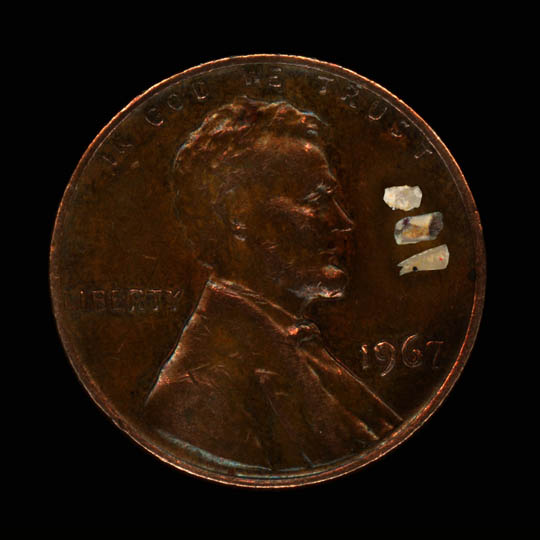
The quotes from the paper continue:
3. “When I first looked at Archaeopteryx [bone chips], it looked like lizard bone. This told me right off the bat that Archaeopteryx was an animal that grew slowly. This was a surprise and not what was expected for a same-sized living bird.” (Erickson)
4. “Living birds mature very quickly and grow really, really fast. This is why we see flocks of pigeons that all look the same and rarely see baby birds.” (Erickson)
5. “Archaeopteryx had comparable metabolism to closely related Velociraptor. Although the genealogy of birds is well understood, the genesis of modern bird biology has been a huge mystery. We knew that they are a kind of dinosaur, but now know that the transition into true birds ‘physiologically and metabolically’ happened well after Archaeopteryx.” (Norell)
6. “We show that avian flight was achieved with the physiology of a dinosaur.” (Erickson)
So, how can the biblical creation scientist logically summarize these findings? First, the bone study on the Munich specimen concurs with the previous findings that Archaeopteryx is not a bird, but is a dinosaur. Secondly, evolutionists can only continue to assume that birds evolved from dinosaurs. There is nothing in the findings of this research, other than evolutionary presuppositions, that would indicate anything about dinosaurs learning to fly and then becoming birds.
Here is a reconstruction of the skeleton of the Archaeopteryx based on multiple specimens because no one specimen found up to this date is complete:
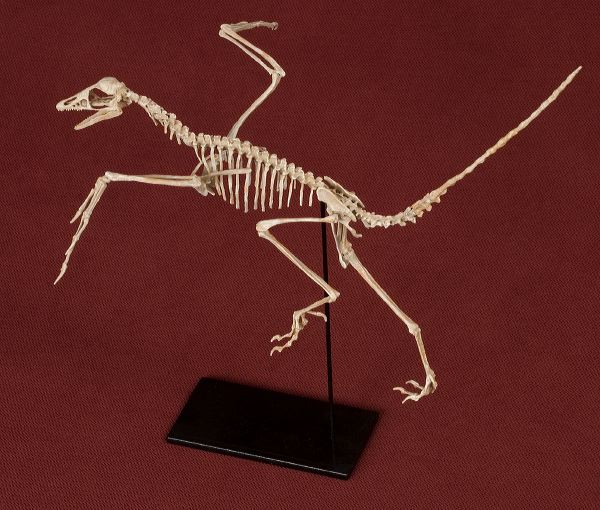
Notice that this reconstruction looks like a dinosaur with legs that pivot at the hips. Birds do not have long femurs like this reconstruction and birds use the bones from the knee down to walk. Birds are “knee walkers” not “hip walkers.”
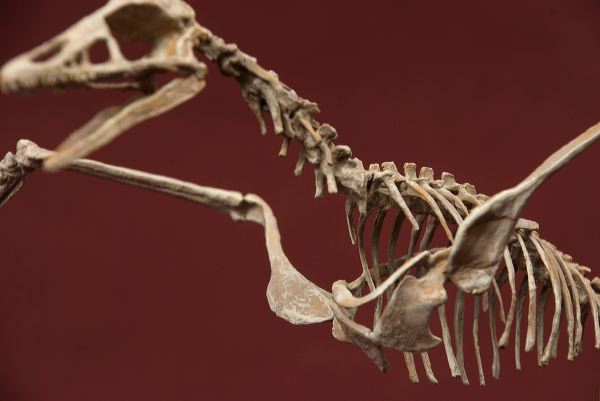
In the above photo of the same reconstruction the furcula can be seen that looks just like that of a Theropod dinosaur. Bird wishbones are shaped with a sharp ‘V’ at the vertex not more like a ‘U’ as in dinosaurs. Also note that there is no deep sternum as in a flying bird. The humerus bones are relatively long and thin. So without a robust sternum and a strong humerus, there is no way this animal would have been able to fly. This is all dinosaur skeletal anatomy and not bird anatomy!
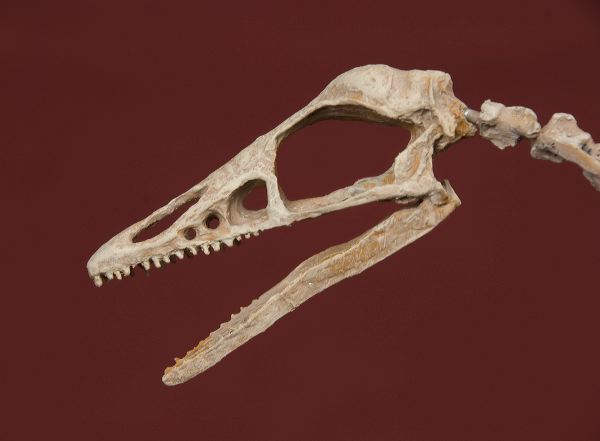
In the above Archaeopteryx skull reconstruction the Theropod dinosaur resemblance is easily seen. The vertebrae are connected to the back of the skull as in dinosaurs and not from the bottom as in birds. This too is all dinosaur anatomy!
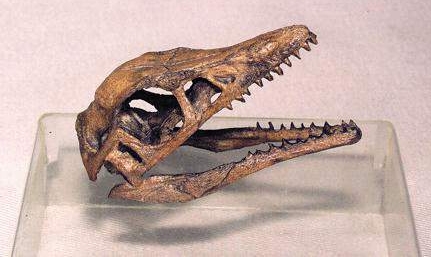

The above two photos show Archaeopteryx (left) and Velociraptor dinosaur (right) reconstructive skulls side by side and the similarities are extremely striking! It seems to this writer that Archaeopteryx is a dinosaur and should be called Compsognathus or Griposaurus.
B. Thermopolis Specimen:
Here below is a photo of the recently discovered (uncovered?) Thermopolis specimen attributed to Archaeopteryx:
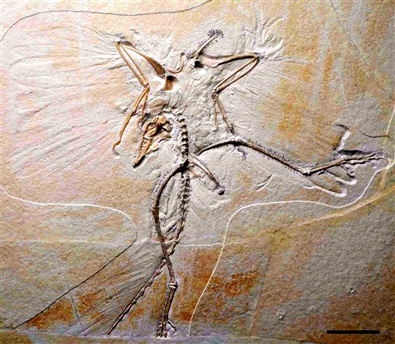
Before getting into the details of the published research on this specimen, here follows what is generally known about it:
1. It was thought to have been in the estate of a Swiss fossil collector who passed away in the 1970s.
2. It was eventually purchased by Mr. Burkhard Pohl of the USA using funds from an anonymous donor.
3. Only the slab exists there is evidently no known counterslab.
4. The fossil is currently based at the Wyoming Dinosaur Center in east Thermopolis, Wyoming, thus the name for the specimen.
Here are some things that are not known, or at least not made public about this specimen:
1. Where exactly was it found?
2. When was it found?
3. Who found it?
4. Who prepared it?
5. How many hands has it passed through for preparation and resale, i.e. what is its history?
6. What happened to the counterslab?
7. How can we possibly know it is authentic?
The current USA displays of the specimen promote this specimen as proving that Archaeopteryx had feathers and that Archaeopteryx is a transitional form between dinosaurs and birds. They also state that it proves Darwin’s Theory of evolution. However, with the seven very serious questions above clouding this specimen, the biblical creationist would do well to ignore it, in my opinion. Questions about the two other specimens with feather imprints are magnified by orders of magnitude with the Thermopolis specimen. As K.N. Whetstone wrote about the London specimen in 1983, “The first skeleton of Archaeopteryx lithographica was discovered in Bavaria in 1861. Although the details of its discovery are unknown…”
Anyway at least some secular scientists believe the Thermopolis specimen is authentic and have performed non-destructive testing on the slab and its contents and have published some papers. The results of this testing follow:
- “In the skull of the Thermopolis specimen a bone in the snout called the ‘palatine’ is better preserved than in any other specimen. The new bone shows that Archaeopteryx had a primitive meat-eating dinosaur palatine with four prongs, rather than the three-pronged palatine seen in more advanced birds,” the specimen shows that its feet and ankles were almost identical to those of its close relatives, such as Velociraptor.” (From Wyoming Dinosaur Center website.)
- Using Synchrotron Rapid Scanning X-Ray Fluorescence techniques and using evolutionary presuppositions, the researchers gathered information on the amount of iron, manganese, copper, calcium, silicon, phosphorus, and sulfur at some locations of the slab and in some skeletal and feather imprint areas. From those element counts they reported that they thought they could see differences in the bone, claw and skull areas from the feather imprint areas. They conclude that the element counts indicate the tested organic materials are original even though they believe they must be 150 million years old.
However, the above beliefs and speculations about the Thermopolis specimen can be countered by biblical creationist conclusions as follows:
1. Nothing about the fossil really indicates transitional forms. The claws, bones, skull, sternum etc. are visibly similar to those in the other specimens. No part of the animal is seen to be in the process of changing from being dinosaur-like to being bird-like.
2. All fossil structures are complete, functional, and very complex. They are just as complex as the most derived dinosaur parts in the evolutionary fossil collection drawers.
3. Everything about the fossil, except for the feather imprints (that may be fraudulent) indicates Theropod dinosaur.
4. Nothing about the fossil, except the feather imprints (that may be fraudulent) indicates it could fly.
5. Nothing about the fossil, except for the feather imprints (that may be fraudulent) indicates bird-like anatomy.
6. And, the elephant in the room is why would we expect that there would be preservation of original organic material in this frail animal after 150 million years? Could it be that the specimen is about 4,500 years old and the feather imprints just over 100 years old? The answer is, of course!
J.D. Mitchell
Click here to get this information as a PDF file: https://www.creationengineeringconcepts.org/wp-content/uploads/2018/07/ARCHAEOPTERYX_UPDATE.pdf
Click here to buy my book on fossils including Archaeopteryx.


